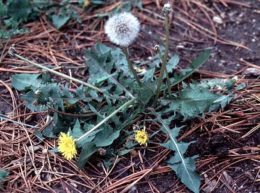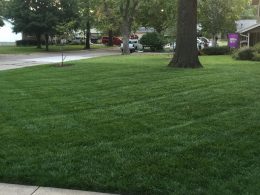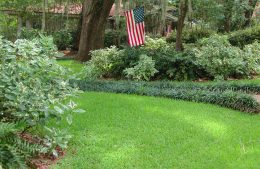 A weed is a plant out of place! Dandelion sure fits that definition! Dandelion is a perennial herb that forms a rosette in lawns and gardens. Inflorescence composed of yellow ray florets that give rise to a “puffball” head. New plants germinate primarily in the fall (late September). Mid-October and November is the most effective time to control broadleaf weeds, including dandelions in lawns. Dandelion usually produces a flush of new plants in late September. These young plants are small and easily controlled with herbicides such as 2,4-D or combination products (Trimec, Weed-B-Gon, Weed-Out) that contain 2,4-D, MCPP and Dicamba. Even established dandelions are more easily controlled in the fall rather than in the spring because they are actively moving materials from the top portion of the plant to the roots. Herbicides will translocate to the roots as well and will kill the plant from the roots up. Be sure to choose a day that is 50 degrees or higher. The better the weed is growing, the more weed killer will be moved from the leaves to the roots. Cold temperatures will slow or stop this process. Weed Free Zone (also sold under the name of Speed Zone) contains the three active ingredients mentioned above plus carfentrazone. It gives a quicker response than the other products mentioned and will work better when temperatures drop below 50 degrees.
A weed is a plant out of place! Dandelion sure fits that definition! Dandelion is a perennial herb that forms a rosette in lawns and gardens. Inflorescence composed of yellow ray florets that give rise to a “puffball” head. New plants germinate primarily in the fall (late September). Mid-October and November is the most effective time to control broadleaf weeds, including dandelions in lawns. Dandelion usually produces a flush of new plants in late September. These young plants are small and easily controlled with herbicides such as 2,4-D or combination products (Trimec, Weed-B-Gon, Weed-Out) that contain 2,4-D, MCPP and Dicamba. Even established dandelions are more easily controlled in the fall rather than in the spring because they are actively moving materials from the top portion of the plant to the roots. Herbicides will translocate to the roots as well and will kill the plant from the roots up. Be sure to choose a day that is 50 degrees or higher. The better the weed is growing, the more weed killer will be moved from the leaves to the roots. Cold temperatures will slow or stop this process. Weed Free Zone (also sold under the name of Speed Zone) contains the three active ingredients mentioned above plus carfentrazone. It gives a quicker response than the other products mentioned and will work better when temperatures drop below 50 degrees.
Tag: Horticulture
Fall Season Weed Control
 We often don’t think of weed control occurring in the fall of the year. Some weeds need to be treated in the spring such as crabgrass. Late October to early November is the most effective time to control broadleaf weeds in lawns. Dandelions usually produce a flush of new plants in late September, and the winter annual weeds henbit and chickweed should have germinated in October.
We often don’t think of weed control occurring in the fall of the year. Some weeds need to be treated in the spring such as crabgrass. Late October to early November is the most effective time to control broadleaf weeds in lawns. Dandelions usually produce a flush of new plants in late September, and the winter annual weeds henbit and chickweed should have germinated in October.
These young plants are small and easily controlled with herbicides such as 2,4-D or combination products (Trimec, Weed-B-Gon, Weed-Out) that contain 2,4-D, MCPP and Dicamba. Even established dandelions are more easily controlled now than in the spring because they are actively moving materials from the top portion of the plant to the roots in the fall. Herbicides will translocate to the roots as well and will kill the plant from the roots up.
Choose a day that is 50 degrees or higher. The better the weed is growing, the more weed killer will be moved from the leaves to the roots. Cold temperatures will slow or stop this process. Weed Free Zone (also sold under the name of Speed Zone) contains the three active ingredients mentioned above, plus carfentrazone. It will give a quicker response than the other products mentioned especially as temperatures approach 50 degrees.
Caring For Your Trees
We all know the weather in Kansas can be extreme!
Plants that grow in Kansas have to be tough. Sometimes it doesn’t hurt to help them along a little thought.
Many young, smooth, thin-barked trees such as honey locusts, fruit trees, ashes, oaks, maples, lindens, and willows are susceptible to sunscald and bark cracks. Sunscald normally develops on the south or southwest side of the tree during late winter. Sunny, warm winter days may heat the bark to relatively high temperatures.
Research done in Georgia has shown that the southwest side of the trunk of a peach tree can be 40 degrees warmer than shaded bark. This warming action can cause a loss of cold hardiness of the bark tissue resulting in cells becoming active. These cells then become susceptible to lethal freezing when the temperature drops at night.
The damaged bark tissue becomes sunken and discolored in late spring. Damaged bark will eventually crack and slough off. Trees often recover but need TLC — especially watering during dry weather. Applying a light colored tree wrap from the ground to the start of the first branches can protect recently planted trees. This should be done in October to November and removed the following March. Failure to remove the tree wrap in the spring can prove detrimental to the tree.
Turfgrass Benefits
 Fall is a great time to plant, over seed, core-aerate, power rake and fertilize tall fescue so to continue on the topic of lawns, what are the benefits of grass? Continue reading “Turfgrass Benefits”
Fall is a great time to plant, over seed, core-aerate, power rake and fertilize tall fescue so to continue on the topic of lawns, what are the benefits of grass? Continue reading “Turfgrass Benefits”
When to Culture you Fescue Lawn

This week’s column is about when to culture your tall fescue lawn. Before we get into that I would like to mention that we will accept applications for our Basic Master Gardener Training Course through Friday, September 8. Continue reading “When to Culture you Fescue Lawn”
Harvey County Soil
Horticulturally speaking, much of Harvey County soil dominated by clay. I know there are exceptions but in my experience with lawns here the clay content is very high. Right now is the optimum time to power rake or core-aerate our cool season lawns like tall fescue and Kentucky bluegrass lawns. Continue reading “Harvey County Soil”
State 4-H Horticulture Judging Contest
Here is a question for you!
What is the period of critical water need for beans or peas?
a) Flowering b) head development c) pod enlargement d) root enlargement
This is one of the 4-H Horticulture judging question from the past weekend State 4-H Horticulture Judging Contest! Continue reading “State 4-H Horticulture Judging Contest”

